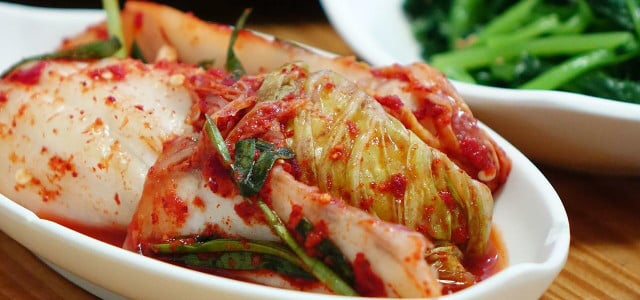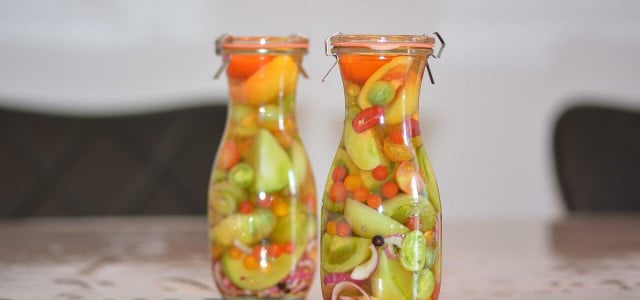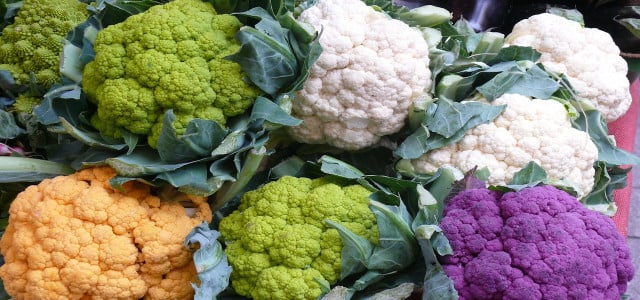Looking for a healthy dish that packs a punch? Adding vegan kimchi is a nutritious way to create some memorable dishes and spice up your diet.
Popularly known as spicy Korean pickled cabbage, kimchi has as many variations as there are cooks. Originating over 2000 years ago in Korea as a way to preserve vegetables, this pickled dish is now a staple in Korean cuisine, being eaten as a side or main dish in nearly every meal. Though spicy kimchi made with cabbage is popular, hundreds of varieties exist with different vegetables, fish or shrimp, or even without the signature red pepper.
Being composed entirely of fermented vegetables, vegan kimchi is also an incredibly healthy dish: it’s low in calories, dense in nutrients, packed with natural probiotics, and may even combat health issues such as obesity, cholesterol, cancer, and constipation. During the fermentation process, beneficial bacteria produce lactic acid and CO2, which prevents the growth of germs and helps preserve kimchi for months.
Once finished, eat your kimchi with rice or use it as a flavorful condiment to any number of dishes:
- Kimchi fried rice or keto cauliflower rice
- Kimchi stew
- kimchi dan dan noodles
- Kimchi chop suey
- Kimchi dumplings or vegan potstickers
- kimchi seasoned tofu
- Kimchi spaghetti
- kimchi veggie sushi rolls
Vegan Kimchi Ingredients
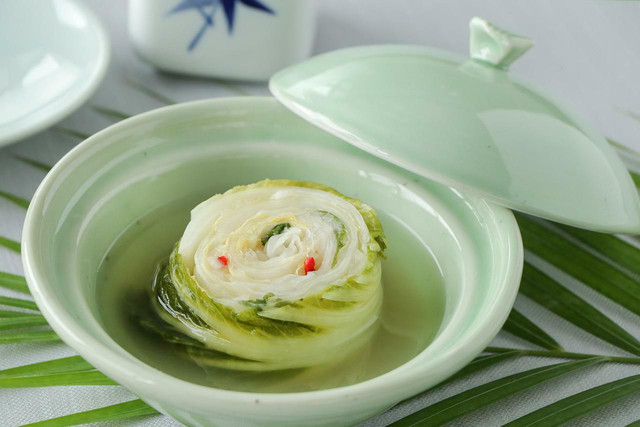


(Foto: CC0 / Pixabay / touchngo)
Though traditionally made with fish sauce, vegan kimchi is a simple alternative that utilizes soy sauce instead. Red kimchi is normally made with Korean red pepper flakes (gochugaru), which are fruitier and less spicy than other varieties. If unavailable, then replace with chili flakes, cayenne, or paprika to add some spice. Fortunately, vegan kimchi is wonderfully versatile and can be made with a variety of different vegetables and spices. Always opt for organic vegetables when available so the fermentation can be as healthy as possible.
Salted Cabbage:
- 5 lbs (approx. 1 large) napa or regular cabbage
- ½ cup kosher or coarse sea salt
Flour Paste:
- ¼ cup flour
- 1½ cup water
- 1 tsp sugar
Blended Paste:
- ½ cup garlic cloves
- 1 tbsp fresh ginger, diced
- 1 onion, diced
- 1 ripe pear, peeled and diced
Other Ingredients:
- ⅛ cup soy sauce
- ½ cup Korean red pepper flakes (gochugaru)
- if unavailable, substitute ¼ cup of chili flakes, paprika, or cayenne pepper
- if you aren’t a fan of spice, then reduce or eliminate the pepper to make white kimchi
- 5-8 green onions/scallions, chopped
- ¼ cup carrots, chopped into matchsticks
- 1 cup white radish or daikon, chopped into matchsticks (avoid regular radishes, as these are too strong)
Equipment:
- Large vessel for fermentation (plastic Tupperware, glass jar, or ceramic crock; do not use metal, which can react with the salt and acid of vegan kimchi)
How to Make Vegan Kimchi
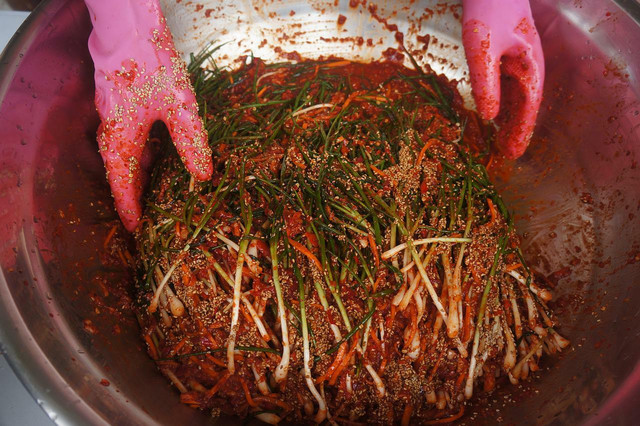


(Foto: CC0 / Pixabay / leemunj)
Vegan kimchi takes preparation, but is smooth sailing once all the ingredients are prepared. To save time, make sure to salt your cabbage first before preparing the rest of the ingredients.
Salt the Cabbage:
Salting the cabbage is essential to drain excess water and prevent spoilage.
- Cut your cabbage into roughly 2 inch pieces and rinse in cold water.
- Drain and place wet cabbage in a large bowl, sprinkle in salt, and mix thoroughly with your hands to coat all of the cabbage.
- Allow your cabbage to salt for about 1½ to 2 hours. The salt will cause the cabbage to release water, wilt, and prevent spoilage.
- The cabbage will be ready when it is bendable and has a slight salty taste when washed. When finished, drain the excess water and soak the cabbage in fresh water to remove any leftover salt.
Make the Flour Paste:
While waiting for your cabbage to salt, make the flour paste. This sticky paste allows the spices to stick to your vegetables and provides fuel for the pro-biotics.
- Mix flour, sugar, and cool water in saucepan and heat up on low. The paste is finished when it has a thick, syrupy consistency.
- Allow flour paste to completely cool before adding it to other ingredients.
Make the Blended Paste:
- Blend garlic, ginger, onion, and pear in a blender or food processor until smooth.
- In a large bowl, combine the cooled flour paste and blended paste. Add soy sauce and red pepper flakes to taste. Tip: if your cabbage is already salty, then skip or reduce the soy sauce. If you don’t like spicy, then consider leaving the pepper out to make a white kimchi.
- Add green onions, carrots, and radish and mix into the paste.
Assembling the Vegan Kimchi:
- Once cabbage is salted and rinsed, take handfuls of the kimchi paste and coat the cabbage, making sure to cover the all pieces of cabbage in paste. Wear rubber gloves to prevent irritation from the spices.
- After the cabbage is coated in sauce, place in a large clean Tupperware, glass jar, or ceramic crock for fermentation. Press down the vegan kimchi so there are no air bubbles and cover the surface with plastic wrap. Because the kimchi will release gas, do not seal it, as this can cause your container to crack.
- Store in a dark place for 1-3 days to allow the kimchi to ferment. Check on your kimchi, push down on the veggies to release bubbles, and taste test each day. Fermentation will give the kimchi a more sour, pickle-like flavor.
- When the desired level of fermentation is reached, place the kimchi into your fridge to halt fermentation. Vegan kimchi will last 3-6 months in in the fridge, but will slowly ferment to become more sour.
*If your vegan kimchi is too pungent, spicy, or salty, then add more carrots or white radish to absorb the flavors.
Read more:
- Sterilizing Jars for Canning: Step By Step Guide
- Natto Recipe: How to Make the Japanese Fermented Beans
- What is Miso Paste? Origin, Production and Nutrition
Do you like this post?






